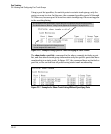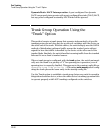
Port Trunking
Trunk Group Operation Using LACP
Table 12-4. LACP Trunk Types
LACP Port Trunk
Configuration
Operation
Dynamic LACP This option automatically establishes an 802.3ad-compliant trunk group, with LACP for the port Type
parameter and DynX for the port Group name, where X is an automatically assigned value from 1 to 24,
depending on how many dynamic and static trunks are currently on the switch. (The switch allows a
maximum of 24 trunk groups in any combination of static and dynamic trunks.)
Note: Dynamic LACP trunks operate only in the default VLAN (unless GVRP is enabled and Forbid is
used to prevent the trunked ports from joining the default VLAN). Thus, if an LACP dynamic port
forms using ports that are not in the default VLAN, the trunk will automatically move to the default
VLAN unless GVRP operation is configured to prevent this from occurring. In some cases, this can
create a traffic loop in your network. For more on this topic, refer to “VLANs and Dynamic LACP” on
page 12-23.
Under the following conditions, the switch automatically establishes a dynamic LACP port trunk group
and assigns a port Group name:
• The ports on both ends of each link have compatible mode settings (speed and duplex).
• The port on one end of each link must be configured for LACP Active and the port on the other end
of the same link must be configured for either LACP Passive or LACP Active. For example:
Switch 1
Port X:
LACP Enable: Active
Port Y:
LACP Enable: Active
Switch 2
Port A:
LACP Enable: Active
Port B:
LACP Enable: Passive
Active-to-Active
Active-to-Passive
Either of the above link configurations allow a dynamic LACP trunk link.
Backup Links: A maximum of eight operating links are allowed in the trunk, but, with dynamic LACP,
you can configure one or more additional (backup) links that the switch automatically activates if a
primary link fails. To configure a link as a standby for an existing eight-port dynamic LACP trunk, ensure
that the ports in the standby link are configured as either active-to-active or active-to-passive between
switches.
Displaying Dynamic LACP Trunk Data: To list the configuration and status for a dynamic LACP trunk,
use the CLI
show lacp command.
Note: The dynamic trunk is automatically created by the switch, and is not listed in the static trunk
listings available in the menu interface or in the CLI show trunk listing.
12-19


















